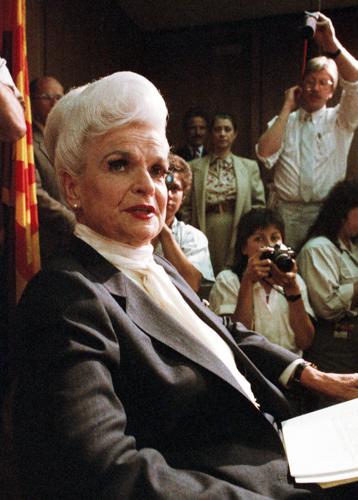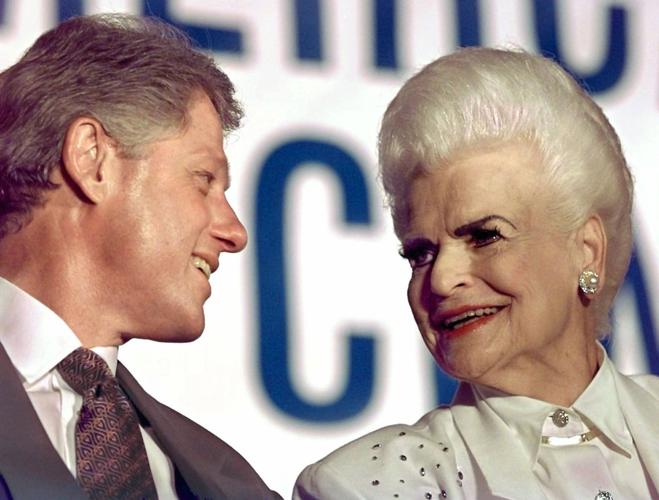Rose Perica Mofford’s political accomplishments are well-known by almost everyone who has lived in Arizona for any length of time.
She rose through the ranks of state government. She was still a teen when she was hired to work as secretary to state Treasurer Joe Hunt. She served a brief stint as business manager for Arizona Highways Magazine, where she increased circulation by nearly 100,000 subscribers. She returned to state service as assistant secretary of state, becoming assistant director of the Department of Revenue and then serving as Arizona’s first female Secretary of State. She became Arizona’s first woman governor in 1988.
Yet there was another side to Mofford that she credited with helping her achieve these impressive credentials. From the time she was old enough to throw a ball, she excelled at almost every sport she played and remained an avid sports enthusiast throughout her life. “I attribute my success to sports,” she said in a 2006 interview, “because I learned to win and learned to lose.”
In 1915, John and Frances Perica emigrated from Austria to the United States, settling in the small mining community of Globe, Arizona. They raised two boys and four girls. Their youngest, Rose, was born on June 10, 1922.
By the age of 6, Rose excelled in sports. Sand lot ball games occurred spontaneously whenever enough kids could be rounded up. Tall, redheaded Rose was usually smack in the middle of any game.
She ran track, played tennis and basketball. And she loved the game of softball.
Mofford claimed she never missed a day of school and, by the time she entered Globe High School, she was a top student, earning perfect grades throughout her high school years. She was elected president of her class every year, voted “most outstanding” student, and selected valedictorian of her 1940 graduating class. She also taught Sunday School at Holy Angels Catholic Church.
Globe “was a wonderful place to grow up,” she said in a 2011 interview. “It was about population 12,000, and you knew everybody, and the teachers, the principal and everybody knew you, so if you got in trouble, your parents knew it before you got home.”
Her athleticism on the basketball court caught the eye of a professional team, the All-American Redheads. She was asked to join the lineup, but she preferred to play softball. She signed on with the Cantaloupe Queens softball team, one of the first women’s softball teams in Arizona. “We were sponsored by the cantaloupe growers,” she said, “and at that time, Phoenix was big into cantaloupe.”
Seventeen-year-old Rose fit the description of an ideal first-base player — tall with a good reach and able to catch throws from every player on the field. She needed to be able to play off base and still get a foot on first base while reaching for a throw. She also could turn quickly and throw to all bases.
Once called “indoor baseball played out-doors,” softball has been around since 1887 with women taking up the sport shortly after its inception. Women’s rules were established in 1926, allowing for smaller bats shaped to fit a woman’s hands, larger balls, and the restructuring of shorter pitching and base paths.
When money became scarce during the Great Depression, paid amusements were abandoned in order to put food on the table. But softball was free and fun and thousands either played the game or enjoyed watching others toss the ball around, smack it into center field, or dive for the impossible catch. Softball became one of the country’s favorite sports.
The first softball championship game took place in Chicago in 1933 and, according to author Erica Westly, “By the late 1930s, women’s softball was more popular than men’s in many places.”
In the summer of 1939, Rose was getting ready to enter her senior year at Globe High School, but she was also defending first base when the Queens set out for Madison Square Garden in New York City. Playing about 20 games as they crossed the country, the Prescott Evening Courier noted on July 14, 1939 that “The Cantaloupe Queens of Phoenix, New York bound all-star softball team, crushed the Prescott Pine Queens at the City park last night, the final score reading 16 to 1 in favour of the Valley girls. Last night’s was the first game of a series of exhibitions the Cantaloupe Queens will play en-route to New York.”
Donning short white satin skirts over even shorter shorts, the Queens quickly earned the title “the most beautiful softball team in the world.” But they played hard and scrappy, as evidenced by the large crowd that greeted them in New York for the three games they played there. Between 18,000 and 20,000 fans jammed Madison Square Garden to watch the Queens take the field. “We wore shorts and looked good in the clothes and we brought the crowds out,” Mofford said. “We were tough on the field and we played hard.”
She left the Queens after graduating from high school, but her time on the field stayed with her as she scaled the highest pinnacles of state government. She was twice inducted into the Arizona Softball Hall of Fame, once for her performance on the field and again for her support of youth and sports.
She was an organizer of the Arizona Softball Foundation and was honored as its 1976 Woman of the Year. On her 75th birthday, the City of Phoenix renamed the Cave Creek Sports Complex the Rose Mofford Sports Complex. She was instrumental in keeping the Arizona Cactus League intact and was inducted into its Hall of Fame in 2014. She was an avid supporter of acquiring the Arizona Diamondbacks. Honored as Arizona’s Outstanding Women of the Year in 1988, Esquire magazine named her one of the “50 Best-Loved Women in America” the following year.
The statuesque lady with an impressive beehive hairdo left her mark on our state and on our lives. She claimed she owed all her success to her parents and to sports. And as her long-time friend Karen Scates fondly noted, “She was the only politician who didn’t get booed at sporting events.”






